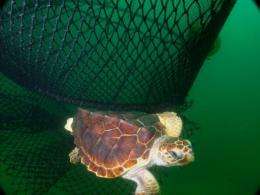This undated handout image received on September 12, courtesy of the National Oceanic and Atmospheric Administration(NOAA), shows a Loggerhead turtle near fishing nets. Improved fishing nets have saved tens of thousands of endangered sea turtles in recent years, but lack of regulations means 4,600 are still dying annually in US shrimp trawls, said a study.
Improved fishing nets have saved tens of thousands of endangered sea turtles in recent years, but 4,600 are still dying annually, mainly in Gulf of Mexico shrimp trawls, said a US study on Wednesday.
Turtle-excluder devices (TEDs), or large holes that allow the creatures to escape from nets that nab smaller marine creatures, have helped cut back on sea turtle deaths up to 94 percent since the 1990s, said the report in the journal Biological Conservation.
The current annual death rate is a "dramatic reduction" from the estimated peak of about 71,000 before protective measures were put in place, said the Duke University-led study which examined data from the US National Marine Fisheries Service on 20 US coastal fisheries.
But major gaps remain, particularly in the Gulf of Mexico and southeastern US shrimp trawl fishery area, where the study said up to 98 percent of all turtle deaths are believed to have occurred in the past two decades.
Shrimp trawlers drag nets along the bottom of the ocean that can capture and kill sea turtles, and the six varieties included in the study are all classified as either threatened or endangered species.
The new fishing nets were introduced in the late 1980s, though design improvements were made as recently as 2003 to make the holes large enough for big turtles to fit through.
TEDs are now mandated by law, but the vast size of the Gulf of Mexico fishing area, where more than 4,700 shrimping vessels work, combined with a lack of independent observers to monitor turtle deaths, or bycatch, means conservationists are unsure how many boats are doing what they should.
"The Southeast/Gulf of Mexico Shrimp Trawl fishery accounts for the overwhelming majority of sea turtle bycatch (up to 98%) in US fisheries, but estimates of bycatch in this fishery are fraught with high uncertainty due to lack of observer coverage," the study said.
Fishing and shrimping is multibillion dollar industry and a major source of income for people in coastal regions of Florida, Louisiana and Texas, an area left reeling from the BP oil spill in 2010.
Study co-author Bryan Wallace said that pushback from the shrimping industry, along with the local culture's tendency to resist government intervention, may play a role in the small number of trained observers who go along on fishing outings to monitor sea turtle interactions.
"Shrimp trawl operations have to have TEDs in their nets installed and operating properly but there have been questions raised as to the extent of that compliance," said Wallace, science director for the Marine Flagship Species Program at Conservation International.
He added that what little scientists do know is "pretty alarming."
"Our numbers are actually likely to be under-estimates," lead author Elena Finkbeiner, of Duke University's Marine Laboratory, said in an interview with AFP.
Elizabeth Griffin Wilson, senior manager for marine wildlife at the advocacy group Oceana, said the study showed "the US approach for dealing with the capture and killing of sea turtles in fisheries is still flawed."
Wilson said Gulf shrimpers are "violating protection measures that allow sea turtles to escape from their nets. As few as 21 percent of shrimp trawl vessels are complying with sea turtle protection measures."
The study authors urged a more comprehensive approach to sea turtle protection, one that moves away from the current practice in which individual fisheries gain government permission to kill a certain number of turtles per year.
"We need to take cumulative accounts of how these fisheries are impacting the sea turtle population and understand how many sea turtles in all can we take in all southeast fisheries in order for this population to still be a viable population," said Finkbeiner.
(c) 2011 AFP



















